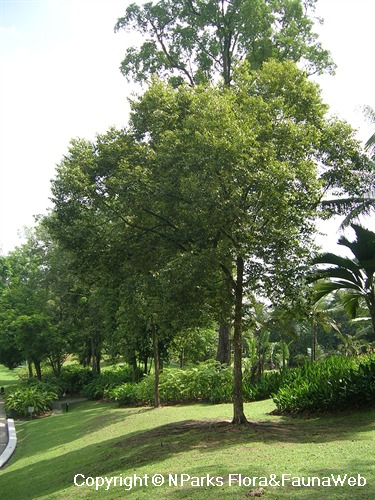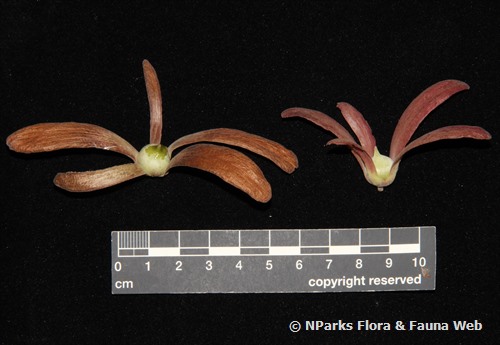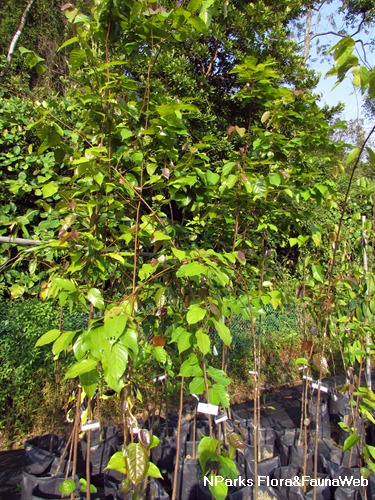_lowres.jpg)
Back
Shorea sumatrana (Slooten ex Thorenaar) Desch
| Family Name: | Dipterocarpaceae |
| Synonyms: | Isoptera sumatrana Slooten ex Thorenaar, Isoptera borneensis auct. non Scheff. ex Burck: King & Gamble |
| Common Name: | Sengkawang, Balau Sengkawang Air, Kedawang |
Shorea sumatrana, also known as Sengkawang is a critically endangered tree in Singapore. Growing up to 30 m tall, it has woody fruit, each with five orbicular calyx lobes. It produces Balau timber, a heavy hardwood that is prized regionally for heavy construction.
Name
Classifications and Characteristics
| Plant Division | Angiosperms (Flowering Seed Plants) |
|---|---|
| Plant Growth Form | Tree |
| Lifespan (in Singapore) | Perennial |
| Mode of Nutrition | Autotrophic |
| Plant Shape | Broad / Mushroom / Hemispherical |
| Maximum Height | 30 m |
Biogeography
| Native Distribution | Thailand, Peninsular Malaysia, Singapore and Sumatra |
|---|---|
| Native Habitat | Terrestrial |
| Preferred Climate Zone | Tropical |
| Local Conservation Status | Native to Singapore (Critically Endangered (CR)) |
Description and Ethnobotany
| Growth Form | It is a tree, up to 30 m tall with buttresses. Bark is smooth with many lenticels when young, and gradually becoming scaly with age. Stipule is lanceolate (7 mm long) and falls off early. |
|---|---|
| Foliage | Leaves are green, papery to thinly leathery and arranged alternately. Each leaf is elliptic to ovate shaped (7 – 14 cm long and 4 – 7 cm wide). The leaf base is blunt to wedge shaped while leaf tip is tapering (0.6 – 1.2 cm long). The upper surface of the leaf is glabrous while the lower surface is scaly (lepidote) or glabrous. Each leaf has 9 – 12 pairs of secondary veins. Both the midrib and secondary veins are sunken above and visible and prominent below. The petiole is slender (1.1 – 1.7 cm long) and sparsely covered with soft hairs. |
| Flowers | Flowers occur in a cluster as a panicle inflorescence at the terminal or axillary position. Inflorescence is single-branched, reaching up to 10 cm long, and comprises of up to 6 flowers. All the flowers on the branch face the same direction (secund). Flower is small, creamy white to pale yellow with pink tinge at base of the petal. The petals are glabrous on the inside while hairy on the outside. Each flower has 22 – 27 stamens with oblong anthers tipped by bristly appendages slightly shorter than anther. The ovary is densely hairy, conical to hourglass-shaped with short smooth style. |
| Fruit | The fruit is woody and covered with soft hairs. Each fruit has 5 orbicular calyx lobes (0-8 – 1.1 cm long and 0.9 – 1.2 cm wide). These calyx lobes are almost equal sized. The orbicular calyx lobe is a key feature to identify Shorea sumatrana. The nut is globose (1.1 – 1.4 cm diameter) with a short tip. |
| Habitat | It is found in swamp forests, and lowland dipterocarp forest, near river bank. |
| Similar | Shorea seminis is very similar to Shorea sumatrana. S. seminis occurs from Borneo and the Philippines, while Shorea sumatrana occurs in Thailand, Peninsular Malaysia, Singapore and Sumatra. |
| Associated Fauna | Flowers are pollinated by insects. |
| Cultivation | It can be propagated by seed. |
| Etymology | Latin Shorea, commemorating Sir John Shore (1793-1798), the Governor-General for the British East India Company; Latin sumatrana, refers to Sumatra, one of the places where it occurs naturally. |
| Ethnobotanical Uses | Timber & Products: it produces Balau timber, a heavy hardwood that is prized regionally for heavy construction, such as bridges, railway sleepers, powerline posts, wagons and fence posts. Others: One mature individual was found in Singapore Botanic Gardens’ Jungle and estimated to be 167 years old. |
Landscaping Features
| Landscape Uses | Reforestation, Parks & Gardens |
|---|
Plant Care and Propagation
| Light Preference | Full Sun |
|---|---|
| Water Preference | Moderate Water |
| Plant Growth Rate | Slow |
| Rootzone Tolerance | Well-Drained Soils, Moist Soils |
Foliar
| Foliage Retention | Evergreen |
|---|---|
| Mature Foliage Colour(s) | Green |
| Mature Foliage Texture(s) | Leathery, Papery |
| Foliar Type | Simple / Unifoliate |
| Foliar Arrangement Along Stem | Alternate |
| Foliar Attachment to Stem | Petiolate |
| Foliar Shape(s) | Non-Palm Foliage (Elliptical, Ovate) |
| Foliar Venation | Pinnate / Net |
| Foliar Margin | Entire |
| Foliar Apex - Tip | Acuminate |
| Foliar Base | Rounded / Obtuse, Cuneate |
| Leaf Area Index (LAI) for Green Plot Ratio | 2.5 (Tree - Open Canopy) |
Non - Foliar and Storage
| Trunk Type (Non Palm) | Woody |
|---|---|
| Mature Bark Texture | Scaly |
| Stem Type & Modification | Woody |
| Root Type | Underground |
Floral (Angiosperm)
| Flower & Plant Sexuality | Bisexual Flowers , Bisexual Flowers |
| Flower Colour(s) | Cream / Off-White |
|---|
| Flower Grouping | Cluster / Inflorescence |
| Flower Location | Axillary, Terminal |
| Flower Symmetry | Radial |
| Individual Flower Shape | Saucer-shaped |
| Inflorescence Type | Panicle |
| Flowering Period | Every Few Years |
| Flowering Habit | Polycarpic |
Fruit, Seed and Spore
| Mature Fruit Colour(s) | Brown |
|---|---|
| Mature Fruit Texture(s) | Hairy / Hirsute |
| Fruit Classification | Simple Fruit |
| Fruit Type | |
| Seed Quantity Per Fruit | Few (1-5) |
References
| References | Ashton, P.S. (1982). Dipterocarpaceae. In: van Steenis, C.G.G.J. (ed.) Flora Malesiana, ser.1, vol. 9, part 2, pp. 237–552, 575–600. The Hague/Boston/London: Martinus Nijhoff/Dr. W. Junk Publishers. Ganesan, S.K. & Ali Ibrahim (2018). Shorea sumatrana (Dipterocarpaceae), a remarkable new addition to the flora of Singapore. Gardens’ Bulletin Singapore 70: 261–266. Pooma, R., Poopath, M. & Newman, M.F. (2017). Dipterocarpaceae. In: Santisuk, T. & Balsev, H. (eds) Flora of Thailand, vol. 13, part 4, pp. 557–685. Bangkok: The Forest Herbarium, Royal Forest Department. |
|---|
Image Repository
Others
| Master ID | 1835 |
|---|---|
| Species ID | 3128 |
| Flora Disclaimer | The information in this website has been compiled from reliable sources, such as reference works on medicinal plants. It is not a substitute for medical advice or treatment and NParks does not purport to provide any medical advice. Readers should always consult his/her physician before using or consuming a plant for medicinal purposes. |

_lowres.jpg)











_lowres.jpg)



